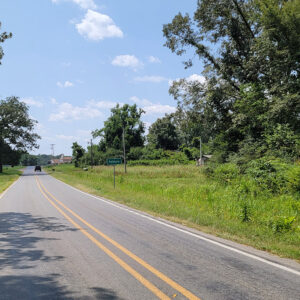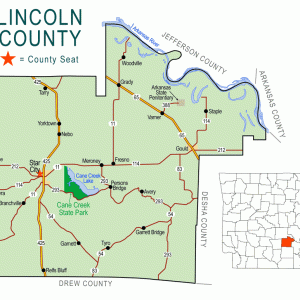calsfoundation@cals.org
Palmyra (Lincoln County)
Palmyra is an unincorporated community in southwestern Lincoln County, about five miles west of Star City (Lincoln County) on State Highway 114. Its most distinctive landmark is Bethlehem Missionary Baptist Church.
The Baptist church was organized on July 18, 1861, but it met only sporadically during the Civil War. By 1867, it was meeting regularly again; church records show a membership that year of forty-four members—forty who were white and four who were African American. At this time, the church was located in Drew County, as Lincoln County was not created until 1871.
Historian William McGriff provides a somewhat tortured explanation of the naming of Palmyra, suggesting that the name honors the memory of Myra Collins, daughter of early settler John Collins, who owned the first store built in Palmyra. The presence of the Baptist church makes it more likely that the community was named for the Syrian city mentioned in the Bible in 2 Chronicles 8:4. The settlement was also known as Sixteenth, because it was located in the sixteenth section of the county as counted by surveyors.
During the 1870s, two railroads were built through Lincoln County. They were both known by various names, and both eventually became the property of the Missouri Pacific Railway. The line that came near Palmyra extended north to Pine Bluff (Jefferson County) and south to Monticello (Drew County) and beyond into Louisiana. No record exists of a railroad depot in Palmyra, but the establishment of a post office there in 1877 indicates the influence of the railroad construction. Around the same time, Collins relocated his store, probably to be closer to the railroad. Luther Owen opened a store in Palmyra around 1885. A cotton gin also operated north of Palmyra.
The Collins store was destroyed by fire, but the other store continued to operate, passing through various owners over the years. In 1910, a two-story building was constructed, with the store and post office on the first floor and a Woodmen of the World lodge and a doctor’s office on the second floor. In 1933, Guy Glover opened a store in Palmyra. His business was so successful that he bought out the older competition in 1942 and moved into the two-story building. A sawmill was built by J. O. Henry Sawmill Enterprise around this time, and Groundhog and Cross tie mills provided jobs for a while. There was also a grist mill in Palmyra.
In addition to cotton, area farms also grew sorghum for molasses and various vegetables, as well as raising cattle and hogs. During the Depression, farmers often bartered eggs, butter, and live chickens for other commodities at the store in Palmyra. The Baptist church built a new church building in 1955–1956.
In 1957, the store burned to the ground. Although the store was rebuilt, the post office was closed at that time. Before 1983, competition from supermarkets led the owners of the store to close and relocate to Star City. A road atlas published late in the twentieth century shows the railroad line still passing near Palmyra, but the rails had been removed well before 2016. No record exists of a school in Palmyra; children from the community probably traveled the short distance to schools in Star City, as they do in the twenty-first century.
For additional information:
History of Lincoln County, Arkansas, 1871–1983. Dallas, TX: Taylor Publishing Company, 1983.
Steven Teske
Butler Center for Arkansas Studies
 Entering Palmyra
Entering Palmyra  Lincoln County Map
Lincoln County Map  Palmyra Cemetery
Palmyra Cemetery  Palmyra Church
Palmyra Church 




Comments
No comments on this entry yet.